The first part of this summary focuses on Poland. (part 2 – Czech Republic, part 3 – Hungary, part 4 – Lithuania, part 5 – Ukraine)
Population: 38.5 mln
Internet users: 11.4 mln (29.9%)
In case of Poland we can present two datasets (as this is the data we have from Ranking.pl) – users of the Polish Internet who come from Poland and users who come from outside of Poland.
The emigrants group is important because it brings us the numbers that should be near to Western Europe/US numbers while still in Gemius methodology.
Poland has very stable, big and well organized community lead by two projects. MozillaPL is a community project focused on self support, community activities, extension localization, and is an amazing source of energy. Aviary.pl is much smaller, task oriented group, that is considering itself as fully professional localization team, with a clear entry barrier, rules, internal structure and growing set of projects under its guide. It started as a part of MozillaPL with a goal to provide high quality localization of Firefox and Thunderbird, but now, it localizes big variety of products both commercially and non-commercially.
First, let’s take a look at the current market share of the most important browsers.
Yes, in contrast to the situation in western Europe, America and Asia, Opera does exists on our market and has its share, while Safari (0.1%) and the whole Mac platform are hardly visible.
Looking at the graph on the right, you can see the latest cumulative set with Microsoft Internet Explorer keeping the crown with 59.5% of the market share, Firefox being second with 33.3% and Opera being third with 5.8%.
In terms of engines, Gecko has 34% and MSIE has just dropped below 60% (59.9%) point.
Yes. The results are different to the ones from XiTi Monitor. According to what we know, XiTi measures websites in English, French and Spanish, so they’re most representative in western Europe. For other countries they measure users from those regions who connect to the tracked websites, which distorts the results.
Now, let’s take a look at users from outside of Poland (29% in this group is from England, 16% Germany, 14% USA, 27% other European countries, 14% rest of the world):
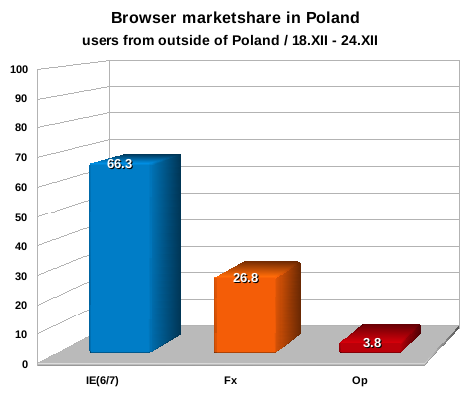 What you can see on the left is lower adoption of Firefox, and higher market share for IE.
What you can see on the left is lower adoption of Firefox, and higher market share for IE.
The simple explanation is… Windows Vista. Vista has 12.5%of the market share among Polish emigrants, and only 4.5% in Poland.
Another reason might be that a very significant part of the emigrants are located in UK, where Firefox adoption is rather slow.
Let’s take a look at the browser adoption rate in a greater detail:
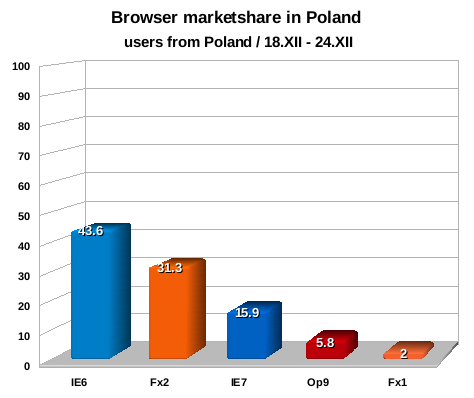 Yes. Firefox 2 after 13 months on the market has 31.3% out of 33.3% shared by all Firefox versions.
Yes. Firefox 2 after 13 months on the market has 31.3% out of 33.3% shared by all Firefox versions.
It means that the length of migration cycle for Firefox is approximately one year and, of course, it’s good for the sake of the web and the progress of the web standard usage.
As you can see from this graph, the situation looks pretty dramatic for IE7. One year after the release, only 15.9% of the market share, means that we’ll need at least another year to see IE7 take the lead.
Or… it may not happen even in this timeframe, at least for Poland, we’ll get back to it later.
IE6’s 43.6% is the lowest point ever, and it’s been loosing ground all the time since the Firefox 1.0 release, and during the last year it was attacked by Firefox 2, Internet Explorer 7 (security upgrade!) and Opera. Even with that, it still holds 46% of the market! It hurts the web. It slows down the evolution of web applications, it lowers the security of Internet and thus makes a lot of people not wanting to invest in the web, or pay by through the web, etc.
To better present the difference in adoption rates, compare those two graphs:
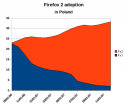 |
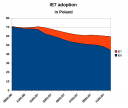 |
left one represents the Firefox 2 adoption rate, and right one IE7 adoption rate. (click to see larger versions of the graphs)
Only 1/3 of IE users has migrated. Bear in mind, that this includes all early adopters, Microsoft Golden Partners, and others who were motivated to do the switch. The raising amount of machines with Vista pre-installed in 2008 will be balanced by the huge group of users who’re not going to change anything for a long time. This group of “conservationists” is huge and will not upgrade for a very long time. It seems that IE7 will pass the 50% point in the IE group not before Q1 2009. If Microsoft will abandon WinXP with IE8, this may even take longer.
Let’s get back to main topic and the emigrants:
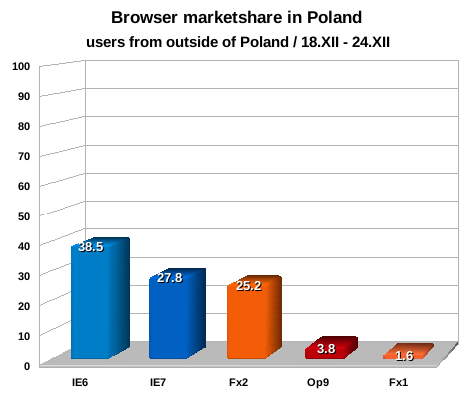 Ok, what this graph reveals is a much better adoption of IE7, which is still rather slow, compered to the migration process of Firefox 2. 95% of the Firefox users have upgraded from the previous versions, whereas in case of IE6, the corresponding figure is only 41.9%.
Ok, what this graph reveals is a much better adoption of IE7, which is still rather slow, compered to the migration process of Firefox 2. 95% of the Firefox users have upgraded from the previous versions, whereas in case of IE6, the corresponding figure is only 41.9%.
Lower Opera usage was expected, since the average numbers for western Europe and US gives Opera around 1-1.5% of the market share. 3.7% is still way over the average. This anomaly is similar to very low Safari usage even in the emigrants group (~0.4-1.0%) and low MacOS usage (1.8%).
It’s important to notice, that the difference between emigrants and Polish users is not because of the higher adoption during this year. In Jan 2007, IE7 has had 1.6% among Polish users and over 15.5% in the emigrants group. So in both groups IE7 has gained around 13% of the market share during this year – only the starting point was different.
We should see IE7 taking the lead during Q2 or Q3 2008.
Now, we’ll focus a bit on the time trends. The goal of these graphs is to answer the question “how has he situation changed in the last 14 weeks”which may but also may not give us a clue on how it can look in the future.
I’m not going to show the direct market share trends, as they change very little during just 2,5 months making it hardly readable (on a 100% scale, a 2% change is almost invisible) . Instead, I’m going to present you the relative trends. Comparing each week to the starting point to present the actual change that happened during this timeframe.
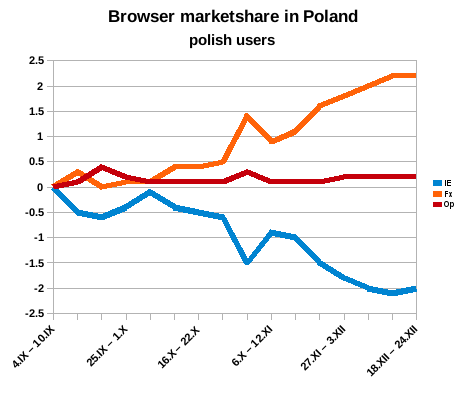 This trend is rather clear. Firefox is gaining market share in Poland. +2.2% in last 4 months. I’m not sure about the reasons for the peak on 5.XI, but since it’s equal in strength for Fx and IE, we can assume that we know who’s taking the market from IE, right? 😉
This trend is rather clear. Firefox is gaining market share in Poland. +2.2% in last 4 months. I’m not sure about the reasons for the peak on 5.XI, but since it’s equal in strength for Fx and IE, we can assume that we know who’s taking the market from IE, right? 😉
what about the emigrants?
 Exactly the same. Firefox gained a bit over 3% of the market share during the last 16 weeks, growing constanly week by week.
Exactly the same. Firefox gained a bit over 3% of the market share during the last 16 weeks, growing constanly week by week.
At the same time IE lost a bit over 4% of the market share, so we can assume that minor players like Opera, Safari and others took their pieces too.
I did not try to match the peaks with important dates or other events, and I didn’t try to create a graph for OS to compare. Maybe someone else will?
Anyway, the message from time trends is clear. IE has been hit during the last 16 weeks and it’s loosing its user base.
Digging deeper, we can do the same time trend, but splitting browsers by their versions. It will tell us which version of which browser is loosing or gaining market.
 Here we are. Firefox 2 gained 3.6% in Poland, IE7 5.7%, while IE6 lost almost 8%. It means, that Firefox and IE7 are sharing almost equal parts of the ground freed by IE6.
Here we are. Firefox 2 gained 3.6% in Poland, IE7 5.7%, while IE6 lost almost 8%. It means, that Firefox and IE7 are sharing almost equal parts of the ground freed by IE6.
Let me repeat it. It means that almost half of the users who resigns from IE6 is switching to Firefox. A half! Pretty much a lot!
Also, you can see that IE7 began to gain market share pretty recently. In November. It’s trend is pretty strong, and we’ll see how it lasts in the next weeks, but as you can see it didn’t stop the Firefox upward trend at all.
I kept Opera trend here, to show how it may look for the browser that keeps it’s user base in the same time frame.
The summary is that IE6 is loosing a lot, IE7 and Firefox are taking its users and the current speed is around 7.5% in 4 months.
 What about those users from outside of Poland?
What about those users from outside of Poland?
The situation is different. Firefox is gaining for the whole time frame, but IE7 was below the line. What does it mean for the new browser to stay below 0-line for a longer time?
Give me another reason, but it seems that users are refusing IE7. For some reason they don’t like it. Of course this can, and will be balanced out by new machines with Vista and IE7 becoming more and more popular, but the “below 0” trend may mean that users who got Vista or got an auto-upgrade, decided not to use IE7 after trying it.
It would confirm my personal experiences of my friends. One of them is working for a IT training school, and said that his students (secretaries, journalists etc.) don’t like IE7 and discover Firefox because… its more intuitive for the former IE6 users.
Last set of time trends is a week to week line graph which shows fluctuations in changes of the market share. It means that it’s not accumulated growth like in the case of the previous graphs, if the browser gained nothing it’s displayed at 0 line, if it gained 1% it shows +1, lose 1%, displays as -1. It’s helpful to analyze the fluctuations in the speed of market share trends.
I also added a linear regression displayed as a dash line that is a very simplified version of saying “this browser adoption speed is speeding up or slowing down”.
 So… Firefox is speeding up in its upward trend and IE is speeding up in its downward trend.
So… Firefox is speeding up in its upward trend and IE is speeding up in its downward trend.
Of course such operations as the one I did here, requires long range data that I currently don’t have to conclude any absolute statements.
For now I can only say that it means that despite IE7, Firefox is in a good position in Poland and should be able to compete IE even when Vista is finally going to start gaining market which should happen next year.
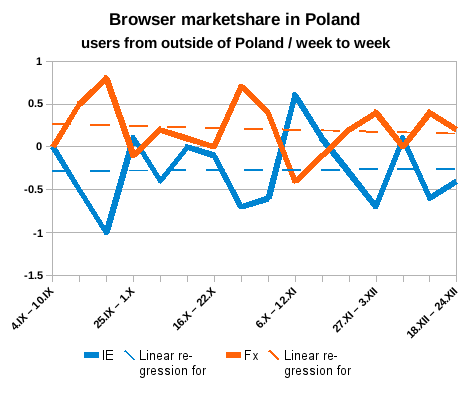 This one is pretty different for emigrants.
This one is pretty different for emigrants.
The trend is slowing down for both, IE and Fx there, which means that the market can be stabilizing or we’ll face a period of IE gains in Q1 next year.
Once more, it’s very hard to conclude anything basing on the data from such a short period. Linear regression tends to overestimate the value of last data entry, and if next week IE will loose more than 0.5%, the line will be very different.
So, I hope it was interesting for you. We know were we are, at least according to Gemius.
In Poland, Firefox has 1/3 of the market, IE7 adoption is at low point but speeding up, almost all Fx users switched to Fx2, Firefox adoption is speeding up right now and a huge amount of the former IE6 users switches to Fx2.
In case of emigrants (most of which are in UK, USA or Germany), Firefox has 26.8%, also almost all its users switched to Fx2, IE7 is gaining, but overall IE is loosing market share.
In the next blog post I’ll show some numbers for Czech Republic. Stay tuned 🙂

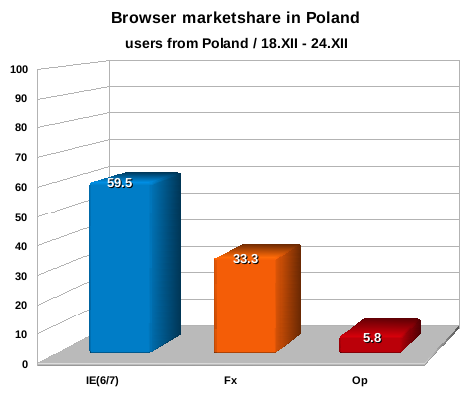
One reply on “Central Europe marketshare situation – short analysis (part 1 / Poland)”
wow, another great article!!! 🙂